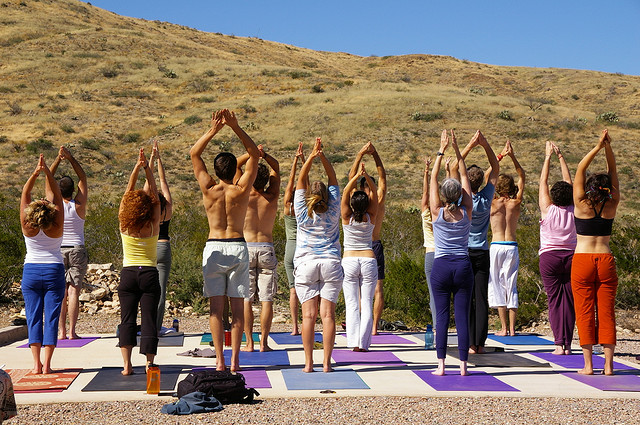
“And just let the heart melt, kind of like an ice cube. It’s a hot day, and the ice cube is on the pavement, and it’s melting—just like your heart, melting into the concrete. Breathe deeply and feel like you are melting.”
I looked around the studio I was practicing in. Yes, I was meant to have my eyes closed, but this imagery was disturbing me; I felt like I was drowning on the concrete.
“Come to sit. Sit evenly, your left sit bone your right sit bone, sit evenly, like you can feel both your sit bones. Can those down the back hear me? Hope I’m not being too loud. When I was younger my mother said…”
Arrgghhh, enough!
I had come to this studio, which I wasn’t a member of, nor did I teach at, to get an idea of what was happening in the local yoga community. From this perspective, it left me with agitation and a disempowered experience of the beauty of yoga.
Language is an art form in of itself, and yoga is a healing art. The importance of being able to reach students beyond the mere physical experience of a yoga practice relies heavily on our ability to utilize a diversity of language, similes and metaphors to create a rich tapestry that weaves our intentions for our classes effortlessly into the students’ practice.
For newer yoga teachers, there can be a vast ocean of learning that comes under many umbrellas. The understanding of the mechanics of the body is of utmost importance to keep our students safe; the creation of sequencing including breath, asana, mantra and many other elements can be tricky to squeeze into a one-hour class. Then there is the challenge of being able to hold space in a room of various abilities, whilst effortlessly guiding all sorts of adjustments to suit the multiplicity of levels in the room.
The truth is, being able to lead your class effectively in and out of transitions, working with the rhythm of the breath and creating an experience that leaves students feeling deeply connected to self is a tall order.
But there are some phrases that will definitely pull the focus away from students and their experience of self, possibly leading them down a road less travelled with no map, compass or yoga mat:
1. Filler words.
Ah, those comfortable little utterances that are muttered when we lose track of what we are saying, don’t know what we are saying, freak out because it’s too quiet, love the sound of our own voice, think the students enjoy our endless dialogue about how much we know about what we are teaching and so on. If any of these sound familiar, then it’s time to do a spring clean of your verbal environment:
So from here step your right foot forward.
And then we will come into Dancer Pose.
Anyway come into a forward fold.
Alright step back into down dog.
Go ahead and stretch the right leg to the back.
Now you’re gonna extend your arms out.
2. Diversity of Language.
The larger the pool of yoga and yoga studios becomes, the more choice our students have in attending classes whenever and wherever. What is it that is going to keep them coming back to your classes?
Maya Angeou said people will forget what you said, people will forget what you did, but people will never forget how you made them feel.
Remember, yoga is a healing art, not just an exercise routine. So embellish the language a little. Head to your nearest Thesaurus and start by looking up how many different words there are for breathe, stretch, lift and turn, just to name a few.
Your ability to say the exact same thing in a variety of different ways, will keep your students engaged and interested. The power of our “feeling” cues, dives students deep into the experience of what is happening from the inside out, rather then the outside in. This means you will need to get in amongst your students, be in the experience unfolding and be mindful of…
3. Disempowering language.
This can be a tricky one. Sometimes it feels useful to throw an open-to-interpretation comment out there. The only problem is, the habit detracts from clarity, intention and strength of our teaching instruction. Some of those instructions include:
Sort of squeeze the left butt cheek.
Kind of relax the shoulders.
What I’d like you to do is step forward into down dog.
Whenever you’re ready come up from Childs pose.
4. Inner Voice.
Ever had those moment when you look around at your class and decide they are not enjoying their practice? Or what about that moment in the second side of your sequence when you completely forget what the next move is, draw a blank and proceed to berate yourself for the rest of the practice. Although it can be humorous to sometimes share our internal dialogue, too much sharing takes away the focus from the student and becomes more about the process of teaching.
Sorry, so sorry, what I meant to do is….
This is what I was aiming for…
Hope I’m not being too loud…
I’ve got you in the wrong direction…
Is everyone having fun?
Teaching can be full of lively insight, experience and nuances, not just a bone-dry recitation of information. So use language that appeals to sensations and feelings. We owe it to our students to continually refine our language and make changes when it is muddled, ineffective or unclear.
Make your class the one that students want to get to, for fear of missing out on your rainbow of descriptions if they are not there to absorb it.
~
Relephant Read:
5 cues yoga teachers give (that are sometimes missed)
~
Author: Michelle Jayne
Editor: Toby Israel
Photo: Diamond Mountain/Flickr
~











Read 2 comments and reply